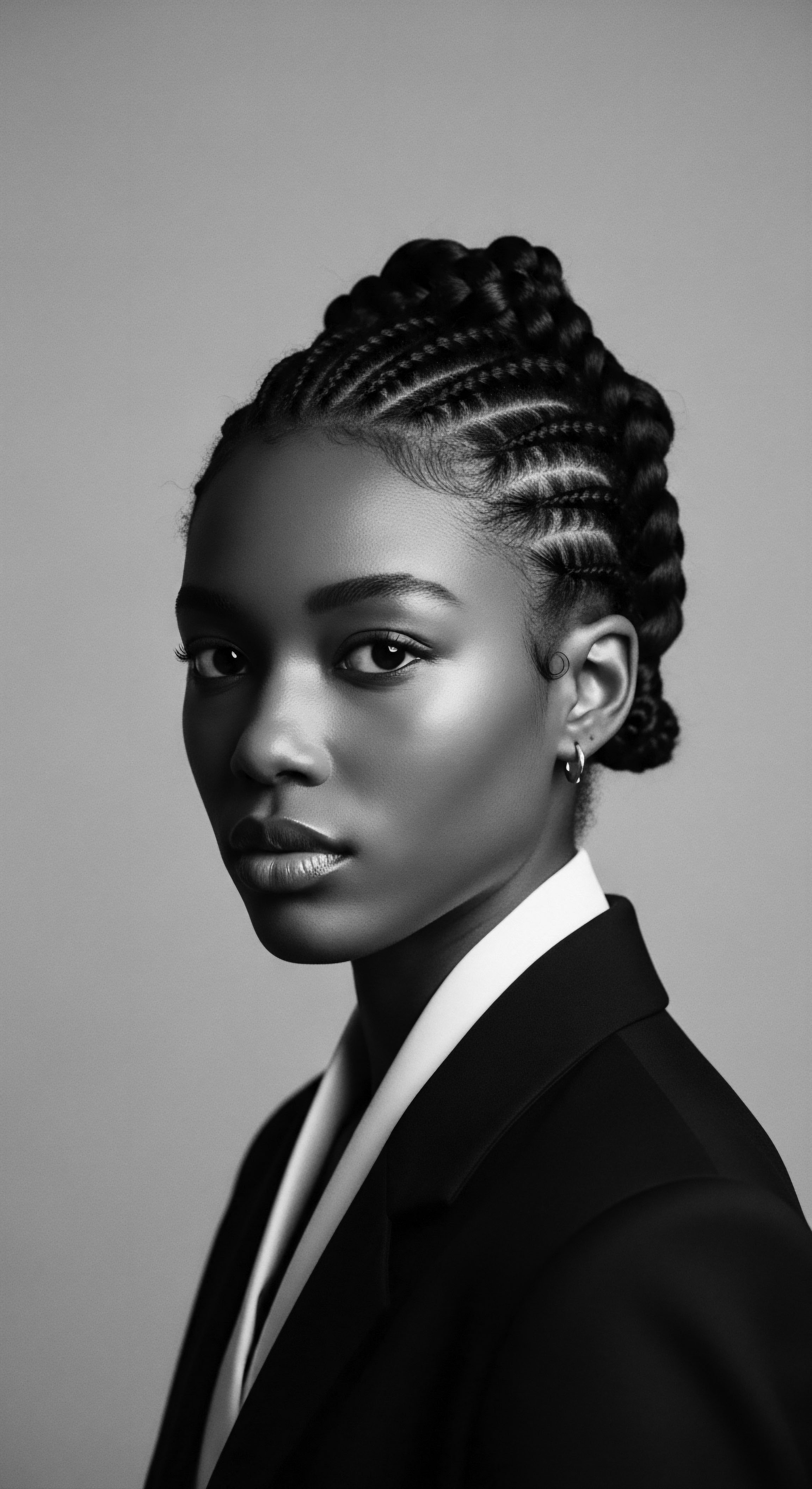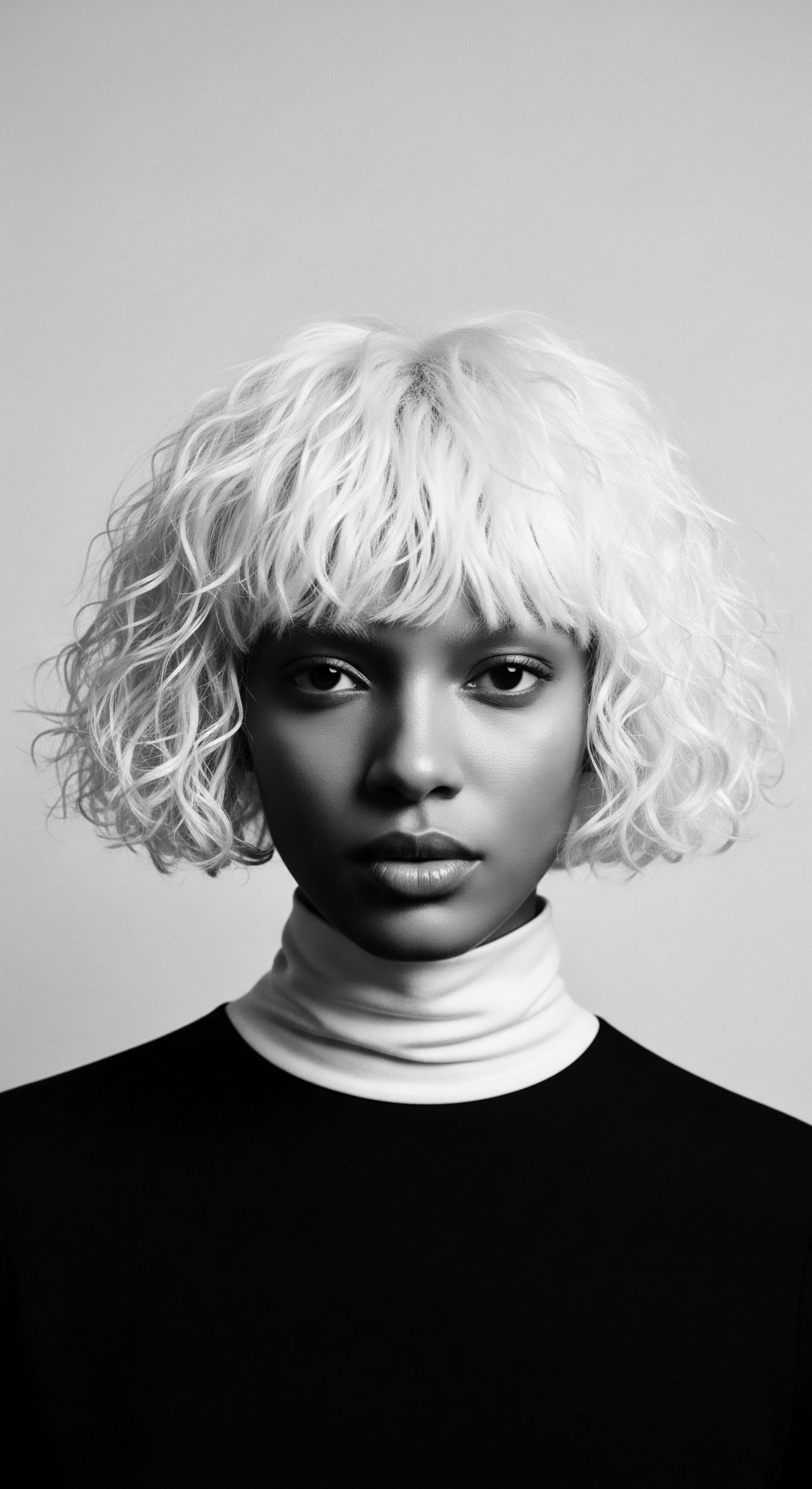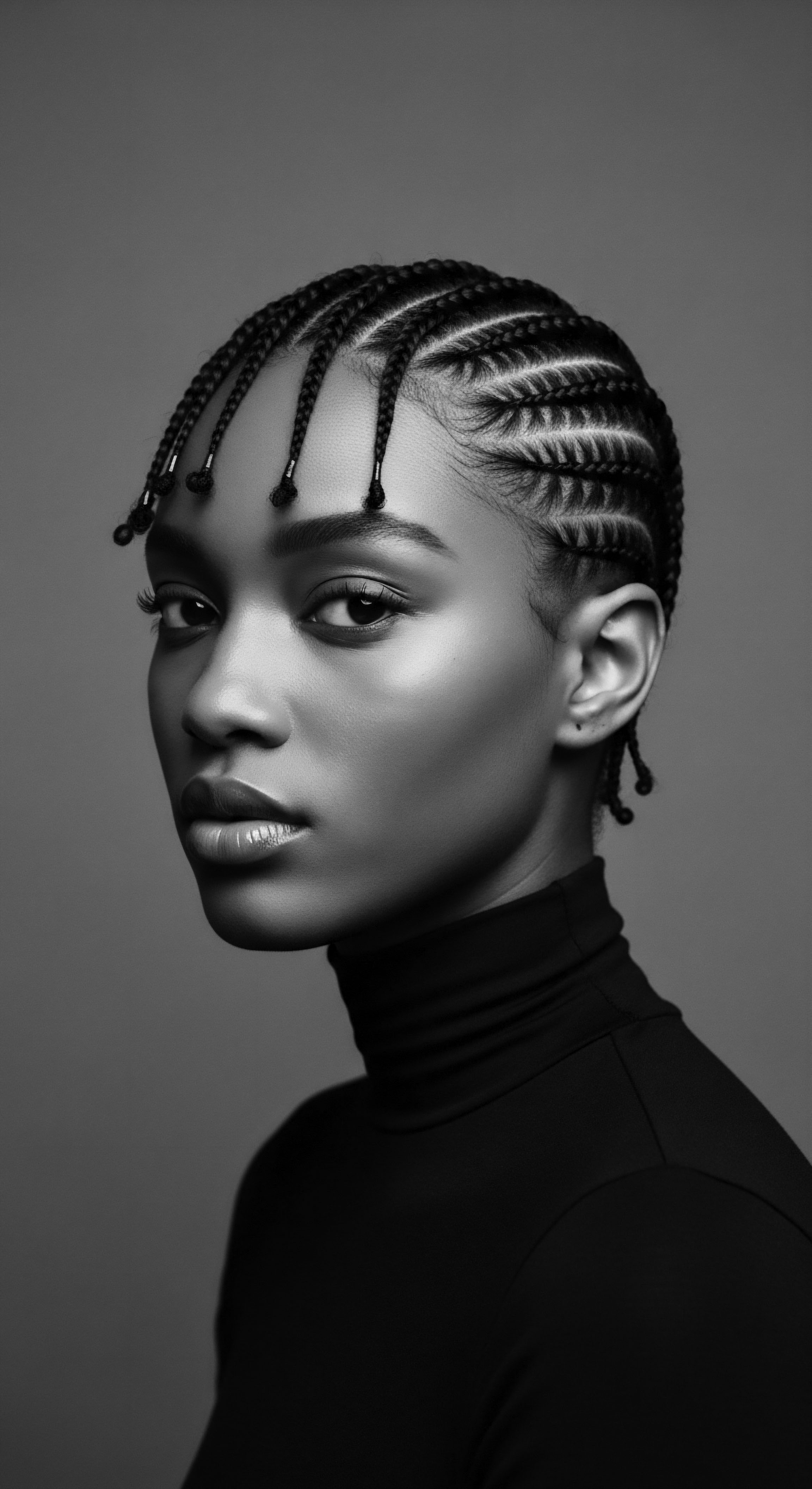
Roots
To stand upon the fertile ground of our hair’s present story, one must first feel the earth beneath one’s feet, sensing the whispers of ancestors who walked these paths long before. For textured hair, particularly within Black and mixed-race communities, every coil, every wave, every tightly wound strand carries a living archive of heritage. It is here, at the very inception, that we begin to understand how styles, deeply rooted in history, served not merely as adornment but as profound declarations of identity, well-being, and protection. Braids, in their countless forms, are not simply patterns on a head; they are ancient blueprints of care, passed down through generations, their function as protective styles for textured hair undeniably supported by a wealth of historical evidence.

The Architecture of Textured Hair
The unique helical structure of textured hair, with its elliptical cross-section and varied curl patterns, distinguishes it from other hair types. This unique biological make-up renders it prone to dryness and breakage without proper care. When strands coil and curve, the cuticle layers, which are the hair’s outermost shield, lift at these bends, making it more challenging for natural oils (sebum) to travel down the hair shaft.
This inherent characteristic, understood intuitively by our forebears and later illuminated by modern science, created a historical imperative for styling practices that safeguarded the hair’s structural integrity. These traditional methods acted as a crucial defense against environmental stressors and daily manipulation.
Ancestral Knowledge recognized the vulnerability of hair to the elements—harsh sun, wind, dust—and the necessity of minimizing physical interference. This understanding guided the creation of styling forms that gathered the hair, tucking away delicate ends and securing the length. These solutions were not accidental; they were responses to elemental biology, crafted with deep respect for the hair’s living needs.
Braids, ancient blueprints of care, stand as profound declarations of identity, well-being, and vital protection for textured hair.

Hair Classification Systems and Cultural Echoes
While contemporary hair classification systems often focus on numerical curl types (like 3C or 4A), ancient societies possessed their own intricate ways of recognizing hair forms, often linking them to social standing, age, or tribal affiliations. These systems, though not formalized in the scientific sense we understand today, were a deeply embedded part of communal life. Archaeological findings, such as rock paintings in the Sahara dating back to 3500 BCE, reveal women adorned with cornrows, evidencing the early and sustained presence of braided styles.
In ancient Egypt, hairstyles indicated a person’s age, marital status, and social class. Young girls wore distinctive “side-locks” symbolizing youth, while married women and priestesses sported more elaborate, structured styles, many of which incorporated braids.
The recognition of differing hair textures, and the subsequent development of diverse braiding techniques suited for them, speaks to a sophisticated historical understanding of hair’s varied needs. This intimate knowledge ensured that the chosen style not only communicated social messages but also served a practical purpose in preserving the hair’s health across a spectrum of textures.

The Lexicon of Hair’s Past
To truly grasp the wisdom of ancient hair practices, we must also consider the language that described them. Beyond scientific terms like ‘cortex’ or ‘cuticle,’ our ancestors had their own specialized lexicon, rooted in their daily lives and spiritual beliefs. These words often described not just the style, but its purpose, its social meaning, or the ritual around its creation.
For example, in Yoruba culture, “Irun Kiko” describes a form of thread-wrapping, recognized as early as the 15th century as a method for length retention. This term itself implies the practical application of care, distinguishing it from purely decorative styling.
Consider some traditional techniques and their practical roles:
- Cornrows ❉ Tightly woven braids lying flat against the scalp, minimizing daily manipulation and protecting against environmental exposure. These can be traced back thousands of years in African civilizations, including ancient Egypt.
- Bantu Knots ❉ Sections of hair twisted into tight, small coiled knots. They serve as protective styles that reduce manipulation and breakage, fostering healthy hair growth.
- African Threading (Irun Kiko) ❉ A technique using thread to wrap hair, aiding in length retention by protecting strands from breakage and stretching hair without heat.
These terms carry the weight of generations, each word a testament to the meticulous care and communal wisdom applied to textured hair.

Ritual
The ritual of braiding for textured hair transcends mere technique; it embodies a living tradition, a continuity of care that stretches back through time. This is where the wisdom of the hand meets the knowledge of the strand, where ancestral practices come into vivid focus as acts of preservation and self-reclamation. Braids, at their core, represent a historical shield, guarding textured hair against the relentless sun, abrasive elements, and the daily wear of life.

Ancestral Roots of Protective Styling
From the Sahara’s ancient rock paintings to the intricate styles of West African tribes, the evidence is compelling ❉ braids served a dual purpose of aesthetic expression and practical protection. In ancient African civilizations, elaborate braided or twisted styles were a signature look among women, often styled communally using natural butters and botanical blends. These styles preserved hair’s health against sun damage and drying winds.
The Himba people of Namibia, for instance, have used various braiding styles, including dreadlocks, covered with a mixture of goat hair, red ochre paste, and butter, to protect themselves from the sun for thousands of years. Their traditional mixture, Otjize, provides not only cultural symbolism but also practical protection from sun and insects.
The practice of braiding was not just a means of beauty; it was a response to the inherent needs of tightly coiled hair. By gathering hair into secure formations, braids minimized tangling, reduced the need for frequent manipulation, and contained moisture. This thoughtful approach mitigated breakage and promoted length retention, principles now validated by modern hair science.

How Did Early Civilizations Approach Hair Preservation?
Historical accounts and archaeological findings demonstrate that ancient communities developed sophisticated methods for hair preservation. In ancient Egypt, both men and women of the elite class wore elaborate wigs that were intricately braided, symbolizing wealth and religious devotion. These wigs, sometimes made from human hair, wool, and plant fibers, also offered protection to the scalp from the sun, particularly for those who shaved their heads for cleanliness.
The Kushites, like the Egyptians, valued elaborate hairstyles as markers of status, and their royalty often incorporated tight, coiled braids into their headdresses, sometimes adorned with jewels, feathers, and metals. These styles were recorded in temple carvings, underscoring their cultural and practical significance.
| Traditional Braiding Style Cornrows (Canerows) |
| Historical Origin & Cultural Context Ancient African civilizations (e.g. Sahara, Egypt, West African tribes) dating back to 3500 BCE. Used to convey status, age, tribal affiliation, and even secret messages during slavery. |
| Protective Benefit Minimizes daily manipulation, protects from environmental exposure, reduces breakage, maintains neatness in demanding conditions. |
| Traditional Braiding Style Himba Otjize-Coated Braids |
| Historical Origin & Cultural Context Himba people of Namibia, dating back thousands of years. Reflects age, marital status, and life stages. |
| Protective Benefit Offers sun protection, deters insects, and provides moisture to the hair due to the mixture of ochre, butterfat, and herbs. |
| Traditional Braiding Style Box Braids |
| Historical Origin & Cultural Context Traced to South Africa at least 5000 years ago. Signified wealth and societal standing. |
| Protective Benefit Reduces friction, prevents tangling, allows for length retention by keeping hair contained and undisturbed for extended periods. |
| Traditional Braiding Style These ancestral techniques highlight the deliberate wisdom behind protective braiding, linking aesthetic expression to hair health and cultural continuity. |

Braids as Tools of Resistance and Survival
The protective nature of braids extended beyond physical preservation; it encompassed the preservation of culture, spirit, and even freedom during the transatlantic slave trade. Enslaved Africans, stripped of many aspects of their identity, held onto hair braiding as a vital link to their heritage and a means of silent communication. This period represents a particularly poignant chapter in the history of protective styles.
One powerful historical example concerns the use of cornrows during slavery as a means of encoding messages and maps for escape routes . In regions like Colombia, cornrow patterns were designed to guide individuals to safety, illustrating a remarkable fusion of practicality and strategic communication. Moreover, enslaved women would braid seeds, rice, or other grains into their hair or their children’s hair, ensuring a means of survival and sustenance after escape.
This practice showcases a profound understanding of braids as secure, concealed vessels, capable of preserving not only hair but life itself. The ingenuity and resilience inherent in these actions underscore the deeply protective role braids played in the lives of those enduring unimaginable hardship.
Beyond aesthetics, braids served as a historical shield for textured hair, embodying acts of preservation and deep cultural continuity.
This period saw an evolution of braiding, influenced by the diverse African cultures brought together by force. Despite oppressive conditions, the act of braiding fostered social bonds and allowed individuals to recreate a sense of cultural continuity, an act essential for collective resilience. The techniques themselves, whether for protection from labor or as hidden conduits for survival, speak to the inherent protective capacity braids possessed.

Relay
The lineage of braiding as a protective style stretches across continents and centuries, a testament to its enduring wisdom. This continuation, a relay of knowledge from one generation to the next, reveals a profound cultural intelligence where hair care is interwoven with holistic well-being and problem-solving, all deeply connected to heritage. The efficacy of braids in safeguarding textured hair is not a modern discovery; it is a validation of practices honed over millennia, refined by ancestral observation and communal practice.

Braids and Holistic Hair Health
The concept of hair health in traditional African communities was seldom isolated from overall well-being. Hair was considered sacred, a conduit to the divine, and its care was often part of spiritual practices. This holistic perspective naturally aligned with practices that minimized harm and fostered vitality.
Braids, by keeping hair contained and reducing exposure to environmental factors like sun, dust, and wind, directly contributed to this idea of health. They minimized the friction and manipulation that can lead to breakage, particularly for hair with its distinctive coiled structure, which is prone to dryness and fragility.
Scientific understanding now confirms what ancestral wisdom long held ❉ reduced manipulation allows hair to retain its natural oils and moisture, leading to less breakage and improved length retention. Braids serve as a stable foundation, allowing the hair a period of rest from daily combing, brushing, and styling, which can be particularly taxing on delicate strands. This historical understanding of “rest” for hair, achieved through braiding, is a core principle of modern protective styling.
The integration of natural ingredients into these traditional braiding rituals also played a pivotal role in promoting hair health.
Consider these historically used ingredients, many still valued today:
- Shea Butter ❉ A staple derived from the nuts of the shea tree, rich in vitamins and fatty acids, used to moisturize and protect hair.
- Coconut Oil ❉ Valued for its moisturizing and conditioning properties, it improves scalp health and supports hair growth.
- Baobab Oil ❉ Extracted from the baobab tree, known for its nourishing properties and widespread use in ancient African beauty regimens.
- Rhassoul Clay ❉ From Morocco, this mud wash cleanses hair and scalp without stripping natural oils, eliminating product build-up.
- African Black Soap ❉ Traditionally made from plantain skins and palm oil, a gentle cleanser for scalp and hair.
These elements, applied during the braiding process or as part of accompanying rituals, speak to a complete system of care that understood the hair’s needs from root to tip.

What Role Did Braids Play in Adapting to New Climates?
When African populations were forcibly displaced across the globe, particularly during the transatlantic slave trade, braids took on new, critical adaptive roles. Stripped of familiar environments and traditional resources, enslaved people relied on the resilience of braiding to maintain their hair under harsh conditions. The immediate practical need was to keep hair manageable, clean, and safeguarded against the elements encountered in unfamiliar landscapes, be it the scorching sun of plantations or environments with limited access to water for washing.
Braids provided a structured style that required minimal daily upkeep, thereby reducing tangles and breakage from strenuous labor. This allowed for extended periods between more extensive care sessions, a necessity when time and resources were scarce.
This adaptation was not merely about survival; it was also about maintaining dignity and cultural connection in the face of dehumanization. The ability of braids to protect hair from environmental damage, coupled with their low-maintenance nature, made them an indispensable practice for survival in new and often hostile environments.

Braiding as a Foundation for Problem Solving
Beyond prevention, braids also served as a means of addressing hair challenges. The very act of sectioning and braiding can aid in detangling, preventing the formation of larger knots that could lead to significant breakage. For those experiencing thinning or breakage, braids offered a method to secure fragile hair, providing support and reducing further stress. This historical application parallels modern dermatological advice for hair conditions that benefit from reduced manipulation and tension, such as traction alopecia prevention through careful braiding practices.
The ancestral ingenuity in adapting braiding to solve immediate hair problems, from minimizing damage in harsh climates to secretly communicating routes to freedom, underscores the deep practical and cultural knowledge embedded in these styles. The relay of this understanding, from ancient communities to contemporary practitioners, solidifies braids as a foundational element in the care and preservation of textured hair.

Reflection
Standing at the close of this exploration, one cannot help but feel the deep reverberations of history in every textured strand. The story of braids as protective styles is more than a chronological account; it is a profound meditation on the enduring strength and adaptability of Black and mixed-race heritage. From the rudimentary needs of ancient anatomies to the complex social tapestries of diasporic communities, braids have consistently risen as a steadfast answer, a silent language of care and continuity. They whisper of grandmothers braiding under starlit skies, of quiet acts of resistance whispered through scalp patterns, of community bonds forged over hours of meticulous finger-work.
This heritage is not a static relic; it is a living, breathing library, each braid a page turned, each style a chapter rewritten. The Soul of a Strand, as we understand it, carries the memory of resilience, the deep intelligence of practices that knew how to shelter and nourish, even when resources were few and the world was unkind. The historical evidence does not merely support the protective efficacy of braids; it sings a song of innovation, cultural pride, and an unyielding commitment to self-preservation. In a world that often seeks to diminish or appropriate, the enduring presence of these ancestral styles is a powerful affirmation ❉ our hair, in its natural glory, carries a legacy of protection that is as old as time, a heritage that continues to shape our present and light the path forward.

References
- Byrd, A. D. & Tharps, L. L. (2014). Hair Story ❉ Untangling the Roots of Black Hair in America. St Martin’s Griffin.
- Dabiri, E. (2020). Twisted ❉ The Tangled History of Black Hair Culture. Harper Perennial.
- Davis-Sivasothy, A. (2011). The Science of Black Hair ❉ A Comprehensive Guide to Textured Care. Saga Publishing.
- Jackson, T. (2001). Plaited Glory ❉ The History of Black Hair. St. Martin’s Griffin.
- Nwankwo, C. C. (2017). African Hair Braiding ❉ A Cultural and Historical Perspective. Ohio State University.
- Wong, N. Williams, K. Tolliver, S. & Potts, G. (2025). Historical Perspectives on Hair Care and Common Styling Practices in Black Women. Cutis, 115(3), 163-166.
